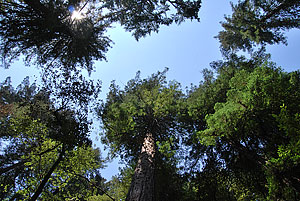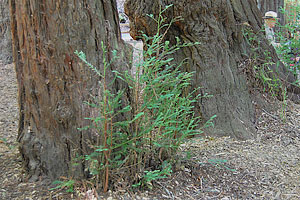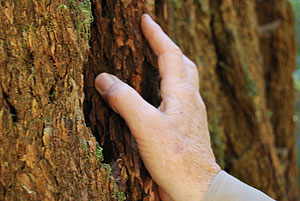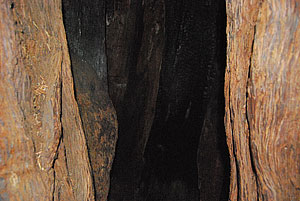Location
The park is 15 miles west of San Rafael on Sir Francis Drake Boulevard.
P.O. Box 251
Lagunitas, CA 94938
415-488-9897
Please call the park for current hours of operation at the phone number above.
Download a trail map and more about the park.
Special thanks to Ranger Vic Graves and Damien Jones, Supervising State Park Ranger – Marin Sector North Parks of the California State Parks for their participation.
Robin Marks of the Exploratorium contributed to this Exploration.
Resilient Redwoods
The coast redwood is no ordinary tree.
To the superficial onlooker, the redwood's impressive appearance makes a strong impression. But a more intimate study of California's official state tree reveals a less-obvious feat: Sequoia sempervirens (meaning "ever living") is a master of survival.
Few threats short of a chain saw can end an established redwood's life. This resilience comes largely from two of the tree's innate talents: reproduction tricks and defenses that make it almost impervious to injury.
Some Redwood Facts
 The coast redwood, Sequoia sempervirens, grows taller than any other tree species, and is the official state tree of California. Sequoia sempervirens is native only to a sliver of coast along central and northern California, running from just south of Monterey up to the Oregon border, and inland a mere 35 miles. Redwoods require a very particular environment: wet. but not too wet; warm, but not too warm; near the ocean, but not too near. They aren't particularly tolerant of salt, but they depend on the marine fog, which condenses on their leaves and provides water during the otherwise warm, dry, summer months.
The coast redwood, Sequoia sempervirens, grows taller than any other tree species, and is the official state tree of California. Sequoia sempervirens is native only to a sliver of coast along central and northern California, running from just south of Monterey up to the Oregon border, and inland a mere 35 miles. Redwoods require a very particular environment: wet. but not too wet; warm, but not too warm; near the ocean, but not too near. They aren't particularly tolerant of salt, but they depend on the marine fog, which condenses on their leaves and provides water during the otherwise warm, dry, summer months.
Coast redwoods are the tallest trees in the world, and it's not uncommon for them to reach well over 300 feet tall (that's the height of a 30-story building). Enormous trunks make the redwood's mass second only to its inland cousin, the giant sequoia. In fact, a coast redwood isn't even considered "large" until its trunk is about 15 feet in diameter.
But again, these are the tree's superficial traits. Within those double-digit trunks hide centuries of growth rings that wouldn't build up as they do if the redwood wasn't so adept at surviving. While sempervirens isn't the very oldest tree in the world, it's certainly in the top echelon. Fifteen-hundred-year-old trees aren't uncommon, and the oldest known living example has been around for about 2,200 years.
Coast redwoods are often found mixed in with other trees, such as Douglas fir and tanoak, as is the case in Samuel P. Taylor State Park in Marin County. Ferns and brackens often make up the forest's understory. The biggest redwoods grow farther north, where the land is flatter than in the Bay Area, on alluvial plains that are prone to flooding. These floods, which occur about twice a century, actually work in the tree's favor: they deposit an enormous amount of sediment, sometimes two feet per flood, that tends to bury most species. Stuck in the mud, a redwood can generate a new root system to plumb the new, higher level of ground, and thus continue on without competing with other plants for light and nutrients.
Reproduction
 Chances are these redwood shoots are much older than they look. Redwoods sprout these tiny clones of themselves when they are damaged. The little trees can linger for centuries waiting for the right conditions to grow into mature redwoods. Redwoods are adept at making more of themselves, whether by cloning or from seeds. They are an example of the smallest seed-cones giving rise to the most majestic trees. Redwood cones are only about an inch long, and the trees don't reach their most fertile period until they're over 250 years old. After that, they can continue to produce viable seeds for almost 1,000 years.
Chances are these redwood shoots are much older than they look. Redwoods sprout these tiny clones of themselves when they are damaged. The little trees can linger for centuries waiting for the right conditions to grow into mature redwoods. Redwoods are adept at making more of themselves, whether by cloning or from seeds. They are an example of the smallest seed-cones giving rise to the most majestic trees. Redwood cones are only about an inch long, and the trees don't reach their most fertile period until they're over 250 years old. After that, they can continue to produce viable seeds for almost 1,000 years.
Like many conifers, redwoods rely on wind to disperse their seeds. But the tiny seeds (it takes 120,000 of them to weigh a pound!) aren't well-shaped for air travel, and so seldom fall more than 200 feet or so from the parent tree.
Redwood saplings are fast growers: yearlings can sprout up to 18 inches, and youngsters in their first decade can gain up to six feet in a single season. Redwood saplings have an advantage over their neighbors, needing less light to grow than Douglas fir, spruce, and other trees that share forests.
The redwood's niftiest resilience trick is packaged in burls at the base of each tree. These burls are made up of dormant buds, each waiting to sprout into action if the parent tree is damaged. Cut a redwood down, for example, wait three weeks, and you'll find around 100 new baby trees sprouted at its base. Of course, not all these trees will survive, but many of them may, growing at voracious speeds. This stump-sprouting leads to what are called "fairy circles," rings of trees encircling the site where one tree once grew. These circles are easy to find in forests where stumps still remain. Other parks in the Bay Area have ancient fairy circles, huge, cathedral-like rings of millennia-old redwoods surrounding the site of the central tree's long-gone stump.
Burl sprouts need space and light to grow, commodities that are sometimes in short supply in a dense redwood forest. But no problem: these tiny trees are programmed to wait. And wait. And wait. While the sprouts may look like they're six-month-old redwood infants, they may have been hanging around for centuries—yes, centuries; clones of ol" Stumpy, waiting for a neighbor tree to topple and lend them the patch of sunlight that will send them skyward. Ponder that next time you tromp by a redwood stump.
Playing with fire
 It's not uncommon for a redwood to sport a foot-thick layer of bark. Redwood bark is low in oils, making the tree unusually fire resistant. The forests of the northern California coast are no strangers to fire. Fire is the redwood's only real foe, but it can also somewhat beneficial. Semperivens has adapted to life in forests that depend on fire, and researchers have found that old-growth redwoods are subjected to—and usually survive—two or three major blazes every century.
It's not uncommon for a redwood to sport a foot-thick layer of bark. Redwood bark is low in oils, making the tree unusually fire resistant. The forests of the northern California coast are no strangers to fire. Fire is the redwood's only real foe, but it can also somewhat beneficial. Semperivens has adapted to life in forests that depend on fire, and researchers have found that old-growth redwoods are subjected to—and usually survive—two or three major blazes every century.
Next time you walk past a redwood giant, take a moment to consider its bark. This outer skin is a real life preserver. Deeply grooved and spongy to the touch, the fibrous redwood bark can be over a foot thick. Redwood bark contains much less oil than most tree barks, which keeps it from catching fire easily. If the tree does catch fire, the burn usually doesn't circle all the way around the trunk, which would kill the tree. Instead, the flames are more likely to destroy a single patch and some heartwood, leaving blackened cavities that are sometimes big enough to accommodate several people. Early settlers in the west used to corral livestock in these redwood caves by putting fences across the openings, lending these caverns the name "goose pens."
 From inside the Pioneer Tree in Samuel P. Taylor State Park in Marin County, visitors can take stock of the damage from a long-ago forest fire that left the tree standing, but with two hollowed out chambers big enough for a hiker to explore.Being able to withstand fire gives a redwood an obvious advantage over most other forest foliage. Any redwood holding its own after the flames have swept through will find itself surrounded by more light, less competition, and the fallen carcasses of its neighbors to provide nutrients. In other words, if it can survive the onslaught, it will be rewarded.
From inside the Pioneer Tree in Samuel P. Taylor State Park in Marin County, visitors can take stock of the damage from a long-ago forest fire that left the tree standing, but with two hollowed out chambers big enough for a hiker to explore.Being able to withstand fire gives a redwood an obvious advantage over most other forest foliage. Any redwood holding its own after the flames have swept through will find itself surrounded by more light, less competition, and the fallen carcasses of its neighbors to provide nutrients. In other words, if it can survive the onslaught, it will be rewarded.
Redwoods continue to thrive despite fires, floods, and (so far) even the threat posed by logging, thanks to efforts by groups like the Save the Redwoods League. Such groups have been active since early last century, when the effects of logging were becoming clear. Most of the ancient redwood forests that still exist, and many second-growth forests as well, are now on protected public lands. One of the joys of being a Bay Area denizen is that these trees live among us, just across the bridge or down the hill, waiting to welcome admiring visitors.
Latest Visitor Photos




